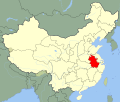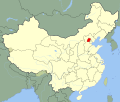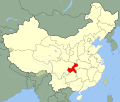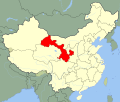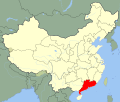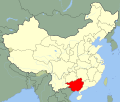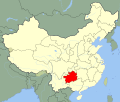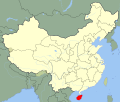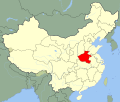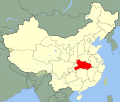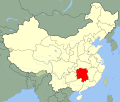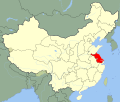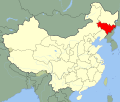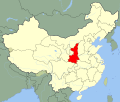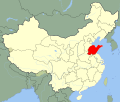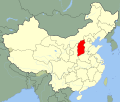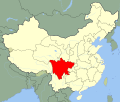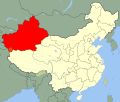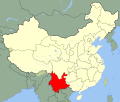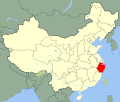Atlas of the People's Republic of China

|
Wikimedia Commons Atlas of the World The Wikimedia Atlas of the World is an organized and commented collection of geographical, political and historical maps available at Wikimedia Commons. Discussion • Update the atlas • Index of the Atlas • Atlas in categories • Other atlases on line |
|
| ||||||||||||||||||||||||||||||||||||||||||
General maps

|
Geographic map of China |

|
Geography of China |

|
Map of China |

|
Map of China |

|
Topographic map |

|
Comparison |

|
Sino-Indian border, eastern section |

|
Sino-Indian border, western section |

|
Notable universities in China |

|
C9 League top universities |

|
China 1st-Grade National Museums |

|
Sacred Mountains of China |

|
Highways of China |

|
Yangtze River Delta city belt |

|
Chine High Speed Railways |

|
China grottoes |

|
Major cities |

|
National Parks |

|
mainlines of railways |

|
major museums |
Maps of divisions
This section holds maps of the administrative divisions.
Shanxi
History maps
This section holds a short summary of the history of the area of present-day China, illustrated with maps, including historical maps of former countries and empires that included present-day China.
- Specific maps of the history of Taiwan are included in the Atlas of the Republic of China.
| China dynasties |
| Huang Di (Ancient China and tribal unions) |
| Map showing the period of Yu the Great and Xia dynasty (2070 - 1600 BC) |
| Shang Dynasty (1600-1027 BC) |
| Situation during the Battle of Muye |
| Zhou Dynasty (1027-221 BC) |
| States of Zhou dynasty |
| Five Hegemons of Spring and Autumn Period |
| Spring and Autumn Period 722-481 BC) |
| Situation during the Battle of Changshao |
| Situation during the Battle of Chengpu |
| Situation during the Battle of Xiao |
| Situation during the Battle of Boju |
| Situation during the Battle of Bi |
| Journey of Confucius |
| Early Warring States Period |
| Warring States Period (5th century-221 BC) |
| Situation during the Battle of Guiling |
| Situation during the Battle of Maling |
| Situation during the Battle of Changping |
| Situation during the Battle of Handan |
| Situation of Qin's unification of China (230 - 221 BC) |
| Qin Dynasty (221-206 BCE) |
| Qin Dynasty |
| Qin dynasty |
| Uprisings of Qin Dynasty |
| The Chu-Han contention |
| The rebellion of seven states |
| The expansion of Han dynasty in 2th century BC |
| Han Dynasty (206 BC-220 AD) |
| Han civilization 87 BCE |
| Xin dynasty(8 - 23) |
| Lulin and Chimei Uprisings of Xin Dynasty |
| Han Civilization 2 BCE |
| Han foreign relations |
| Western Han Dinasty |
| Han Dinasty 189 |
| Yellow Turban Rebellion |
| Warlords of Han |
| Three Kingdoms 220-280 |
| Battle of Yiling |
| Three Kingdoms(220 - 280) |
| Zhuge Liang's Southern Campaign |
| Zhuge Liang 1st and 2nd Northern Expeditions |
| Zhuge Liang 3rd Northern Expedition |
| Zhuge Liang 4th and 5th Northern Expeditions |
| Western Jin Dynasty (265-316) |
| War of the Eight Princes |
| Uprising of Five Barbarians |
| Eastern Jin Dynasty (317-420) |
| Sixteen Kingdoms in 317 |
| Sixteen Kingdoms in 326 |
| Sixteen Kingdoms in 338 |
| Sixteen Kingdoms in 350 |
| Sixteen Kingdoms in 376 |
| Sixteen Kingdoms in 391 |
| Sixteen Kingdoms in 398 |
| Sixteen Kingdoms in 402 |
| Sixteen Kingdoms in 406 |
| Sixteen Kingdoms in 416 |
| Sixteen Kingdoms in 423 |
| Sixteen Kingdoms in 436 |
| Battle of Fei River |
| Battle of Canhe Slope |
| Duan Qi and Ran Wei kingdoms |
| Helian Xia kingdom |
| Huan Wen expeditions |
| Liu Yu expeditions |
| Northern Wei and Liu Song |
| Northern Wei and Southern Qi |
| Eastern Wei, Western Wei and Liang |
| Northern Qi, Northern Zhou and Chen |
| Liu Song dynasty |
| Northern Wei dynasty |
| Northern Qi, Northern Zhou and Chen dynasties |
| Sui dynasty (581 - 618) |
| Territory of Sui |
| Uprisings of Sui |
| Establishment of Tang Dynasty |
| Battle of Hulao |
| China under the Tang Dynasty 608-907 |
| China in 610, (Tang Dynasty 608-907) |
| China in 742, (Tang Dynasty 608-907) |
| Administrative divisions of Tang dynasty in 660-663 |
| The 10 major Jiedushi of Tang dynasty during Emperor Xuanzong's reign |
| Battle of Yinshan Mountains between Tang and Tujue |
| The conquest of Tuyuhun by Tang |
| Battle of Dafeichuan between Tang and Tibetan Empire |
| The wars between Tang and Korean kingdoms |
| The war between Tang and Western Tujue |
| Battle of Talas |
| Tang Dynasty |
| Khitan Rebellion during Wu Zetian's reign |
| An Lushan Rebellion |
| Fanzhens of Tang dynasty during Emperor Xianzong's reign |
| Huang Chao Uprising |
| Balhae Kingdom |
| Kingdom of Khotan |
| Later Liang |
| Later Tang |
| Later Jin |
| Later Han |
| Later Zhou |
| Establishment of Song Dynasty |
| Liao (Khitan) Dynasty and Northern Song |
| Northern Song Dynasty (960-1127) |
| Northern Song |
| Uprisings of Song Jiang and Fang La in Song dynasty |
| Southern Song Dynasty (1127-1279) and Western Xia |
| Western Xia kingdom |
| Dali Kingdom |
| Jurchen Jin Dynasty |
| The wars between Song and Jurchen Jin |
| Western Liao |
| Battle of Qatwan |
| Empire of Genghis Khan at his death in 1227 |
| Mongol invasion |
| Map showing changes in borders of the Mongol Empire from founding by Genghis Khan in 1206, Genghis Khan's death in 1227 to the rule of Kublai Khan (1260–1294). (Uses modern day borders)
Mongol Empire
By 1294 the empire had split into: Empire of the Great Khan (Yuan Dynasty)
|
| Yuan dynasty (1271 - 1368) |
| Uprisings and warlords before the end of Yuan dynasty |
| Ming Dynasty (1368-1644) |
| Ming dynasty |
| Great Wall and Nine Garrisons of Ming Dynasty |
| Tumu Fort Crisis |
| Ming-Turpan Conflict |
| Battle of Ningyuan |
| Battle of Shanhai Pass |
| Southern Ming |
| Three Feudatories rebellion |
| Qing Empire and nearby countries (1700) |
| Qing Dynasty (1820) |
| Qing Dynasty (1892) |
| Boxer Rebellion |
| Mutual Protection of Southeast |
| Viceroys of Qing Dynasty |
| Situation during Northern Expedition |
| Civil War (1928-1937) |
| Republic of China (1930) |
| China Soviet Zones |
| Central Plains War |
| The Long March of Red Army |
| Battle of Luding Bridge |
| Creation of Manchukuo as Japanse puppet state |
| Map of Manchukuo |
| Growth of the Japanese Empire |
| Japanese control after the Second Sino-Japanese War (1940) |
| Situation in 1940 |
| Japanese plans in 1941 |
| Situation in 1944 |
| Situation in April 1944 Ichigo Plan |
| Situation in October 1944 |
| Chinese Civil War in 1947 |
| Chinese Civil War in 1948 |
| Chinese Civil War in early 1949 |
| Chinese Civil War in later 1949 |
| Three Campaigns of Chinese Civil War |
| Pingjin Campaign |
| Movement of the Republic of China to Taiwan |
| Hainan Island Campaign |
Maps of ancient Chinese capital cities
| Luoyang in Han Dynasty |
| Xi'an in Tang Dynasty |
| Kaifeng in Song Dynasty |
| Dadu in Yuan Dynasty |
| Nanjing in Ming Dynasty |
| Beijing in Ming and Qing Dynasties |
| History of Xi'an |
| History of Beijing |
Old maps
This section holds copies of original general maps more than 70 years old.
| Map of China 1936 |
| Map of Manchukuo |
Maps of autonomous regions
- see also Atlas of Hong Kong, Atlas of Macau and Atlas of Tibet
| Location of Inner Mongolia Autonomous Region |
| Tibet Autonomous Region |
| Xinjiang Uygur Autonomous Region |
| Nationalities of Xinjiang Uygur Autonomous Region |
Administrative divisions
| Agricultural regions |
Satellite maps
| Satellite map |
Notes and references
|
General remarks:
|


